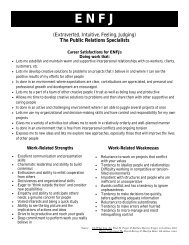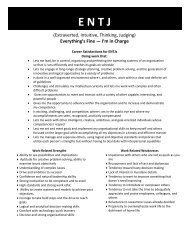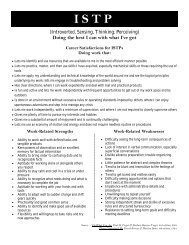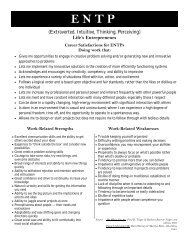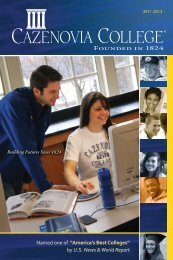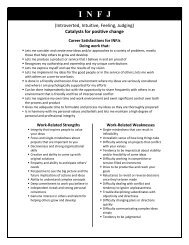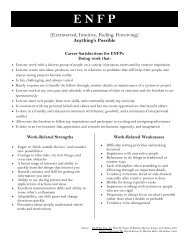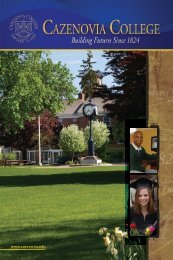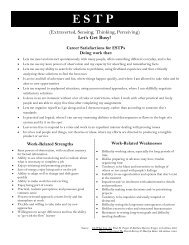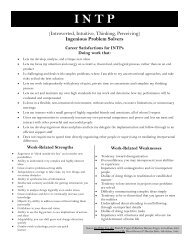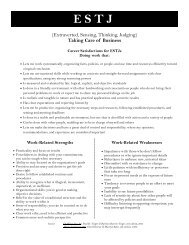of
2013-14 Academic Catalog - Cazenovia College
2013-14 Academic Catalog - Cazenovia College
- No tags were found...
You also want an ePaper? Increase the reach of your titles
YUMPU automatically turns print PDFs into web optimized ePapers that Google loves.
EQ 285 Equine Studies Internship<br />
1-6 credits (CS)<br />
Students who choose to participate in an equine internship<br />
have the opportunity to select their own area <strong>of</strong> emphasis<br />
(e.g. breeding, training, instruction) and to work <strong>of</strong>f-campus<br />
under pr<strong>of</strong>essional guidance to increase their knowledge and<br />
experience. They will work with the equine internship<br />
coordinator to find appropriate placement. No transportation<br />
is provided. Forty internship hours equate to 1 credit hour.<br />
(Offered every semester) Prerequisite: Sophomore standing<br />
in the Equine Business Management specialization and<br />
appropriate level <strong>of</strong> skill relative to site placement; the<br />
program director <strong>of</strong> Equine Business Management has final<br />
approval <strong>of</strong> all internship placements.<br />
EQ 301 Western Horsemanship III<br />
2 credits (fulfills equitation requirement)<br />
Instruction includes refinement <strong>of</strong> position and schooling in<br />
the various forms <strong>of</strong> the gaits, riding ring etiquette and safety,<br />
increasing competency in pattern work and trail class work<br />
and overall increasing competency in the western seat. More<br />
advanced riding theory, additional equipment usage for<br />
specific schooling or showing situations, patterns, and show<br />
ring procedures are included.<br />
A student may repeat this course once for credit. There is an<br />
additional fee for each course. (Offered annually)<br />
Prerequisite: Successful completion <strong>of</strong> two semesters <strong>of</strong> EQ 201.<br />
EQ 302 Hunter Seat Equitation III<br />
2 credits (fulfills equitation requirement)<br />
Instruction includes schooling in the various forms <strong>of</strong> the<br />
gaits, riding ring etiquette and safety, and increasing<br />
competency in the hunter seat. More advanced riding theory,<br />
equipment usage for specific schooling or showing situations,<br />
flatwork appropriate for the hunter, jumper or equitation<br />
horse, exercises over fences for the hunter, jumper or<br />
equitation horse and coursework and show ring procedures<br />
are included.<br />
A student may repeat this course once for credit. There is an<br />
additional fee for each course. (Offered annually)<br />
Prerequisite: Successful completion <strong>of</strong> two semesters <strong>of</strong> EQ202.<br />
EQ 303 Dressage III<br />
2 credits (fulfills equitation requirement)<br />
Instruction includes schooling in the refinement <strong>of</strong> the<br />
dressage seat, basic gaits and paces within the gaits (with<br />
emphasis on improvement by use <strong>of</strong> the training scale),<br />
figures, movements up to and including USEF “First Level”,<br />
lateral work, riding ring etiquette and safety, and development<br />
<strong>of</strong> competency and/or increasing competency in dressage.<br />
Some more advanced work (medium gaits and more<br />
advanced lateral work) may also be included, dependent upon<br />
the progression <strong>of</strong> the rider and horses. Emphasis will be<br />
placed upon the logical sequencing <strong>of</strong> movements in a<br />
training program. Show ring procedures are included.<br />
A student may repeat this course once for credit. There is an<br />
additional fee for each course. (Offered annually)<br />
Prerequisite: Successful completion <strong>of</strong> two semesters <strong>of</strong> EQ 203.<br />
EQ304 Reining III<br />
2 credits (fulfills equitation requirement)<br />
Instruction includes all reining maneuvers, slow small and<br />
large fast circles, spins, lead changes, rollbacks, sliding stops<br />
and back-ups. These maneuvers are done in a specific order,<br />
which are called patterns. These patterns will be performed<br />
with a higher degree <strong>of</strong> competence (than in EQ104 & 204)<br />
by students at the end <strong>of</strong> the semester. The student will also<br />
gain further knowledge <strong>of</strong> the NRHA judging system in order<br />
to score runs. More advanced riding theory, additional<br />
equipment usage, patterns and show ring procedures are<br />
included.<br />
A student may repeat this course once for credit. There is an<br />
additional fee for each course. (Offered annually)<br />
Prerequisite: Successful completion <strong>of</strong> two semesters <strong>of</strong> EQ 204.<br />
EQ 321 Equine Diseases and Injuries I<br />
3 credits (CS/AS)<br />
The student studies the theoretical and practical aspects <strong>of</strong><br />
disease and applies this information to the study <strong>of</strong> diseases<br />
<strong>of</strong> the horse. Recognition <strong>of</strong> normality and degree <strong>of</strong><br />
deviation from normal are stressed along with preventive<br />
medicine. The laboratory sessions emphasize skills such as<br />
measuring vital signs, recognizing deviations from normal<br />
behavior/attitude/measures <strong>of</strong> health as well as skills such as<br />
administering medications. (Offered fall term) Students must<br />
pass with a "C" or better. Prerequisite: SM 215 Equine<br />
Anatomy and Physiology<br />
EQ 322 Equine Diseases and Injuries II<br />
3 credits (CS/AS)<br />
A continuation <strong>of</strong> EQ 321 Equine Disease & Injuries I, this<br />
course places its emphasis on lameness encompassing muscle,<br />
bone and joint disorders associated with the performance<br />
horse, as well as neurological disorders. The discussion <strong>of</strong><br />
treatment and prevention is emphasized, as well as X-ray<br />
analysis. The laboratory portion involves analysis <strong>of</strong> actual<br />
and theoretical cases to ensure the appropriate application <strong>of</strong><br />
knowledge gained through the lectures/discussions. (Offered<br />
spring term) Prerequisite: EQ 321 Equine Diseases and<br />
Injuries I<br />
EQ 323 Equine Reproductive Management<br />
3 credits (CS)<br />
The theoretical and applied aspects <strong>of</strong> the equine<br />
reproductive industry are studied. Topics covered include<br />
mare and stallion reproductive anatomy and physiology,<br />
prenatal development, foaling, neonatal care, reproductive<br />
technologies including semen collection and evaluation,<br />
artificial insemination, cooled and frozen semen techniques,<br />
record keeping and current breeding management topics.<br />
Some practical aspects <strong>of</strong> genetics and pedigree selection may<br />
be included. This course is the basis to the reproductive<br />
management certificate and must be taken prior to EQ 324,<br />
EQ 327 and EQ 427. (Offered fall term)<br />
EQ 324 Breeding Lab Management and Design<br />
1 credit (CS)<br />
This course is a practical application course centered on the<br />
breeding lab. Students utilize the breeding lab at the Equine<br />
Academic Catalog | Cazenovia College | www.cazenovia.edu 156



